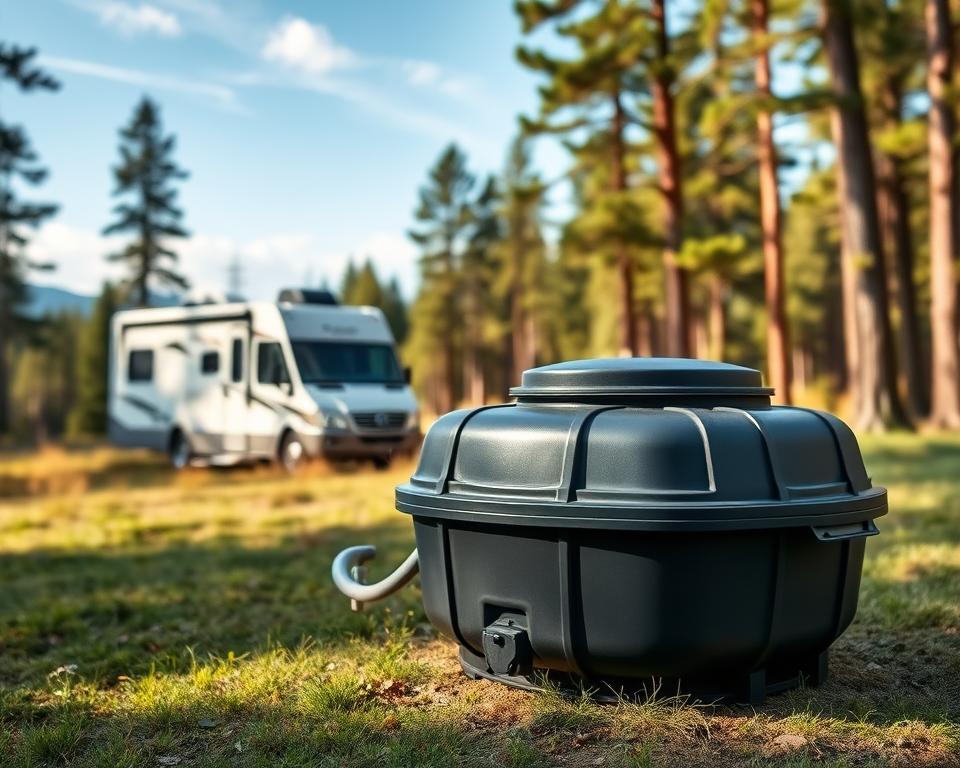Camper Waste Pump Manual: Crucial Care Guidelines
Did you ever ponder the workings of your recreational vehicle sewage network? Grasping the details of your camper sewer pump can avoid mishaps, improving your camping excursions. It’s all about controlling waste effectively and dodging unpleasant aromas. In this handbook, you’ll discover vital maintenance strategies for RV tank pumping. Every tip is designed to support your sewage system’s optimal function.
Grasping Your Recreational Vehicle Sewage Pump Setup
The recreational vehicle waste pump network is essential for waste handling, making outdoor stays more enjoyable. It comprises two principal tanks: the black water tank for bowel output and the grey water tank for water from sinks and showers. Differentiating these tanks is key to prevent clogs and keep your RV functioning efficiently.
An RV waste grinder is a favored option for sewage handling. It shreds solid waste into minute particles, simplifying disposal. In contrast, a classic RV pump is available. It efficiently moves waste without grinding, for those seeking a simpler option.
Familiarizing yourself with your RV’s sewage pumping system is vital to avoiding problems and ensuring clean inspections. Operating the system efficiently can prevent messes, boosting your outdoor adventures.
Why Consistent Upkeep Matters
Caring for your RV sewer pump is vital for a trouble-free journey. Without proper servicing, you may experience odors, clogs, or backups. These problems can ruin your road trips.
Scheduled upkeep thwart such problems and extend your system’s life. By inspecting hoses and seals, you boost efficiency. A well-serviced RV sewage pump guarantees clean waste handling, letting you enjoy continuous journeys.
Consistent attention also results in financial savings over time. Neglect can cause expensive failures, requiring high-cost fixes. Backing regular maintenance keeps your motorhome in peak form, preserving money long term.
How Often Should You Pump Your RV Septic Tank?
Knowing the right time to pump your RV Septic Tank is crucial for its upkeep. It’s suggested to pump every 72–120 hours during use. For quick getaways, pumping on return may work fine.
Interval depends on various elements. Tank size and occupancy are vital. Ideally pump when it reaches two-thirds full. This helps ensure steady waste movement and ward off clogs.
Observing your RV Septic tank levels is essential for a hassle-free trip. Oversee properly your camper’s effluent to avoid issues while traveling.

Optimal Methods for Tank Disposal
Accurately discharging RV tanks is key for your motorhome’s sanitary condition and operation. Start with the black water tank to let the grey tank liquid rinse leftover solids. This strategy stops clogs and ensures seamless flow.
Select a durable sewer hose for disposal. A sturdy hose prevents leaks and ensures connections. Include a tank rinser for a thorough rinse, using water pressure to remove remaining debris, upgrading cleanliness.
Thorough draining prevents residue buildup, preventing foul odors and potential issues. To maintain an optimal sewage system in your motorhome, follow these guidelines:
- Consistently apply a tank additive post-drain to manage smells and break down waste.
- Monitor tank levels to avoid overflows.
- Inspect your RV waste pump regularly for clogs and wear.
- Perform a deep tank flush every 4–8 weeks, even during less frequent trips.
Adopting these techniques enhances your sewage system’s durability and efficiency, ensuring smooth journeys.
Keeping Smells and Blockages at Bay
For a memorable adventure, warding off smells is crucial. Maintain adequate water level to aid in decomposition, avoiding unpleasant odors. Also, opting for RV-approved tissue helps prevent clogs, keeping the system running smoothly.
For improved waste handling in campers, try enzymatic solutions. These process sludge thoroughly, reducing effort. Ensure vent pipe clearance to keep air moving freely in the plumbing system.
Mindful disposal is crucial to avoiding tank issues. Avoid flushing wipes, feminine products, and paper towels. These non-biodegradable items can cause major clogs. Using these practices helps maintain a more sanitary camping environment.
Maintenance Advice for RV Sewage Pumps
Maintaining your RV’s sewer pump system is vital for hassle-free trips. Check valve seal integrity often to stop seepage. Worn seals can cause accidents, harming your RV.
To banish smells and maintain cleanliness, sanitizing is key. Perform a deep clean every few months to avoid deposits, ensuring the system works efficiently. These steps are essential for maintaining a mobile macerator, promoting long life and reliable functionality.
Greasing valve components is another important task. It helps prevent leaks and maximize functionality. Monitoring tank sensors is key for precise measurements, preventing run-ons and unexpected pump issues. Maintaining vigilance makes your RV adventures neater and more enjoyable.
Indicators You Need Expert Pumping
Recognizing waste troubles promptly can ward off major issues. A primary clue you need a pro pump service is sluggish flow. When sinks and toilets take longer to clear, it often points to blockages. It suggests your system may be jammed.
Persistent odors are another distinct indicator of sewage troubles. Unpleasant fumes hanging around despite cleaning suggest trapped waste. It’s crucial to check the transparent elbow fitting when dumping waste. Remaining waste visibility signals it’s time for pro maintenance.
Technicians utilize jet machines to dismantle stubborn blockages efficiently. Ignoring these warnings can lead to major problems. Therefore, it’s imperative to seek help immediately when issues arise.
| Signs of Sewage Issues | Recommended Response |
|---|---|
| Sluggish Emptying | Look for blockages; schedule pro maintenance |
| Ongoing Foul Scents | Inspect fittings; schedule pump-out |
| Remaining Sludge | Call pro for deep cleanse |
How to Pick Your Camper Macerator
When selecting an RV macerator pump, assess its capacity, durability, and compatibility with your RV’s size. A premium macerator is essential for efficiently breaking down waste. This is especially important for RVs requiring constant pumping. High-end pumps optimize sewage handling, ensuring a better travel experience.
A range of options cater to varied requirements. For an well-founded selection, focus on these critical elements:
- Capacity: Verify capacity matches your usage.
- Durability: Choose pumps with robust construction.
- Ease of Use: Choose devices that simplify installation and operation.
- Compatibility: Ensure it integrates with your system.
Taking time to compare when choosing an RV macerator pump improves travel enjoyment and ensures proper sewage disposal.
RV Sewer Pump Troubleshooting
Accurate diagnosis for your RV sewer pump is crucial in fixing common sewage issues before they worsen. If you notice sluggish emptying, surprise blockages, or persistent odors, act quickly. These are definite clues of malfunction requiring attention.
First inspect the pump, its connections, and hoses. Check for any clogs that could slow flow. Ensure inlet and outlet fittings are secure. Also, verify the pump’s power supply for proper voltage.
If basic checks don’t detect the issue, note the pump’s sound. A unit that’s abnormally loud or unusually silent may have internal damage. Also, check for leaks, as these can exacerbate sewage problems. With these troubleshooting steps, many RV owners identify and resolve issues early, avoiding costly repairs.
Long-Term RV Sewer Pump Care
For lasting performance, dedicate yourself to regular sewer pump upkeep. Flush the system consistently to prevent clogs. Set up and observe a maintenance routine, keeping everyone informed of their roles. This markedly extends your waste system’s lifespan.
Informing yourself and others on proper waste disposal is vital. This avertss issues and fosters shared responsibility. The result benefits both users and the sewer system.
- Inspect plumbing and hoses periodically
- Maintain clear filter screens
- Arrange yearly pro maintenance
- Apply recommended conditioners
Following these guidelines enhances your camper’s sewage system’s durability and keeps it functional, making travels more enjoyable.
Wrapping It Up
Keeping your RV sewer pump in prime condition is vital for hassle-free camping adventures. Regular attention to RV sewer system maintenance greatly minimizes problem risks, letting you focus in the journey. By knowing your system and applying reliable sewage methods, your trips will be free of waste management woes.
Applying the critical tips from this guide boosts RV waste management and advances your travel comfort and safety. Keep your sewer pump in top shape by following best upkeep practices and addressing potential issues promptly.
Staying vigilant about your RV sewer system yields benefits. It guarantees homely comforts while exploring. Wishing you joyous and relaxed journeys!
Help Center
How can I tell it’s time to empty my RV Septic tank?
Empty your RV Septic tank once it’s two-thirds full.
Black tank vs. grey tank: what’s the difference?
Black tank is for sewage waste. Whereas, the grey tank collects water from sinks and showers.
How often should I maintain my RV sewer pump system?
Perform maintenance every few months.
Recommended products for RV sewer pump maintenance?
Choose RV-approved enzyme formulas and quality hoses and rinsers.
How to keep my camper’s sewer lines clog-free?
Avoid flushing non-biodegradable items.
What signs indicate I need professional RV pump-out?
Watch for slow drainage, recurring odors, or visible residue in the elbow.
Tips to optimize camper macerator performance?
Ensure capacity and compatibility.
Deep cleaning checklist for RV sewer system?
Flush lines, replace seals, and sanitize components.
Maintaining my RV sewer system over time?
Train users on proper disposal.
Septic pumping frequency for heavy RV use?
Service tank frequently for group travel or heavy usage.
